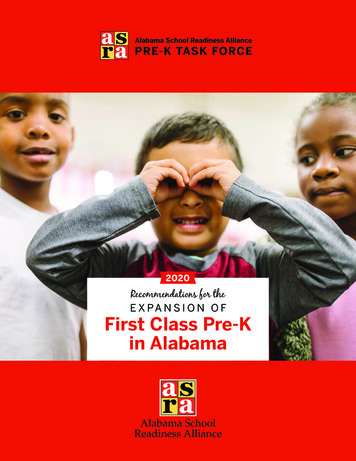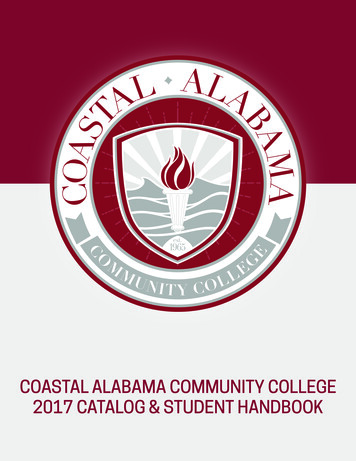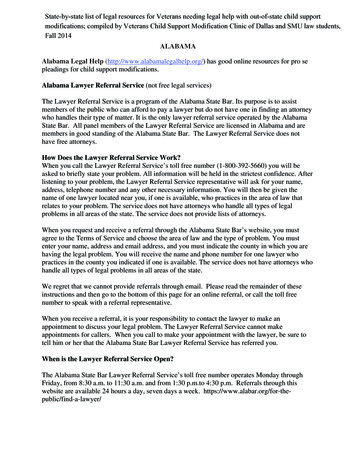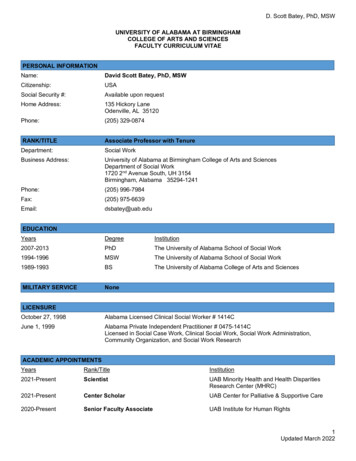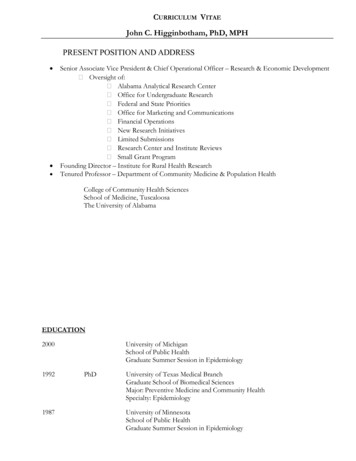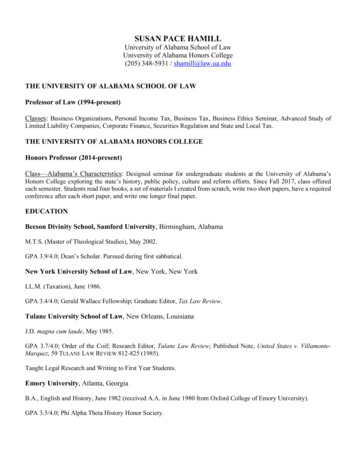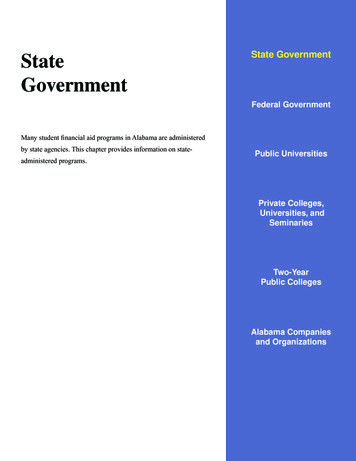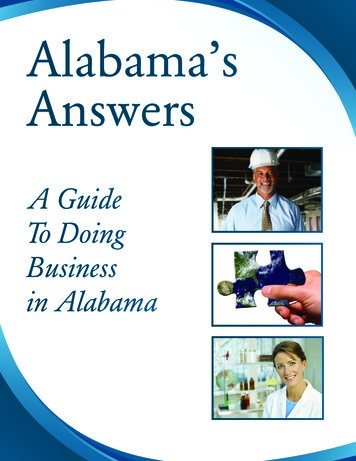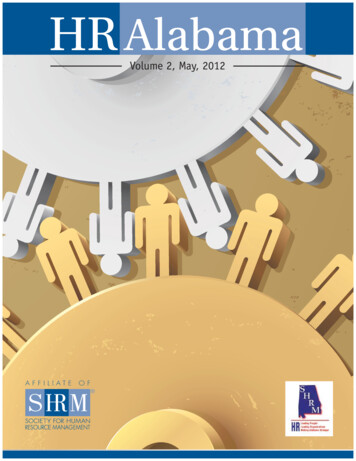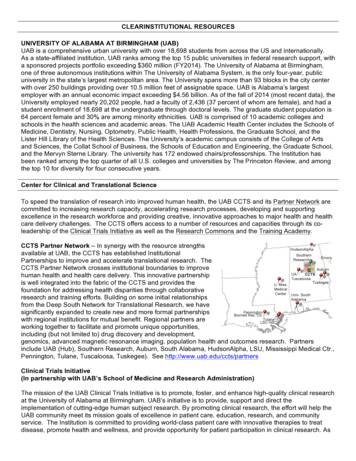
Transcription
CLEARINSTITUTIONAL RESOURCESUNIVERSITY OF ALABAMA AT BIRMINGHAM (UAB)UAB is a comprehensive urban university with over 18,698 students from across the US and internationally.As a state-affiliated institution, UAB ranks among the top 15 public universities in federal research support, witha sponsored projects portfolio exceeding 360 million (FY2014). The University of Alabama at Birmingham,one of three autonomous institutions within The University of Alabama System, is the only four-year, publicuniversity in the state’s largest metropolitan area. The University spans more than 93 blocks in the city centerwith over 250 buildings providing over 10.5 million feet of assignable space. UAB is Alabama’s largestemployer with an annual economic impact exceeding 4.56 billion. As of the fall of 2014 (most recent data), theUniversity employed nearly 20,202 people, had a faculty of 2,436 (37 percent of whom are female), and had astudent enrollment of 18,698 at the undergraduate through doctoral levels. The graduate student population is64 percent female and 30% are among minority ethnicities. UAB is comprised of 10 academic colleges andschools in the health sciences and academic areas. The UAB Academic Health Center includes the Schools ofMedicine, Dentistry, Nursing, Optometry, Public Health, Health Professions, the Graduate School, and theLister Hill Library of the Health Sciences. The University’s academic campus consists of the College of Artsand Sciences, the Collat School of Business, the Schools of Education and Engineering, the Graduate School,and the Mervyn Sterne Library. The university has 172 endowed chairs/professorships. The Institution hasbeen ranked among the top quarter of all U.S. colleges and universities by The Princeton Review, and amongthe top 10 for diversity for four consecutive years.Center for Clinical and Translational ScienceTo speed the translation of research into improved human health, the UAB CCTS and its Partner Network arecommitted to increasing research capacity, accelerating research processes, developing and supportingexcellence in the research workforce and providing creative, innovative approaches to major health and healthcare delivery challenges. The CCTS offers access to a number of resources and capacities through its coleadership of the Clinical Trials Initiative as well as the Research Commons and the Training Academy.CCTS Partner Network – In synergy with the resource strengthsavailable at UAB, the CCTS has established InstitutionalPartnerships to improve and accelerate translational research. TheCCTS Partner Network crosses institutional boundaries to improvehuman health and health care delivery. This innovative partnershipis well integrated into the fabric of the CCTS and provides thefoundation for addressing health disparities through collaborativeresearch and training efforts. Building on some initial relationshipsfrom the Deep South Network for Translational Research, we havesignificantly expanded to create new and more formal partnershipswith regional institutions for mutual benefit. Regional partners areworking together to facilitate and promote unique opportunities,including (but not limited to) drug discovery and development,genomics, advanced magnetic resonance imaging, population health and outcomes research. Partnersinclude UAB (Hub), Southern Research, Auburn, South Alabama, HudsonAlpha, LSU, Mississippi Medical Ctr.,Pennington, Tulane, Tuscaloosa, Tuskegee). See http://www.uab.edu/ccts/partnersClinical Trials Initiative(In partnership with UAB’s School of Medicine and Research Administration)The mission of the UAB Clinical Trials Initiative is to promote, foster, and enhance high-quality clinical researchat the University of Alabama at Birmingham. UAB’s initiative is to provide, support and direct theimplementation of cutting-edge human subject research. By promoting clinical research, the effort will help theUAB community meet its mission goals of excellence in patient care, education, research, and communityservice. The Institution is committed to providing world-class patient care with innovative therapies to treatdisease, promote health and wellness, and provide opportunity for patient participation in clinical research. As
an academic medical center, it is our responsibility to participate in research that leads to new discoveries andadvances the art and science of medicine for future generations. This collaboration provides services to: UAB researchers and research teams, assisting with feasibility assessment, methodologic rigor, studystart-up, implementation and reporting.Patients and the general public, providing opportunities for study participation.Sponsors, helping them identify UAB investigators for participation in their research.As part of this effort, the CCTS mission addresses four programmatic tasks: 1) performance standards to meetand exceed national standards; 2) educated and knowledgeable workforce; 3) implementation of scientificallyreproducible research; and 4) services to support rigorous design and interpretation.CCTS Training AcademyThe CCTS is committed to lifelong training. Its Training Academy offers research training and careerdevelopment to investigators and their teams. In addition to the NIH-funded KL2 and TL1 programs (which areinstitutional training programs similar to K12 and T32 mechanisms), the CCTS offers the Clinical andTranslational Science Training Program and the Research-Team Training Program (both certificate courses).The Clinical and Translational Science Training Program offers additional training in clinical and translationalresearch over a six-month period (January-June) for two hours per week. Course content represents modulesincluding clinical trials, epidemiology, biostatistics, ethics, clinical genetics research, behavioral research,outcomes research, dissemination of results, and grant writing and funding opportunities. All of the sessionsare presented by experienced clinical and translational researchers or individuals with special expertise inareas such as grants and contracts and regulatory issues. Preceptors include faculty and research staff fromacross the Partner Network. The six-session Research-Team Training Program provides research staff(investigators, study coordinators, billing staff, regulatory coordinators, etc.) with the basics of implementingand managing a clinical trial with emphasis on good clinical practices (GCPs), research compliance, and otherkey topics. This Program has been expanded to become a regional training resource for the conduct of clinicaltrials.The CCTS has also recently implemented a Summer Research Training Program in Patient-CenteredOutcomes Research (PCOR) and Comparative Effectiveness Research (CER) for students at UAB andPartner Network institutions, as well as a CCTS/CTO Clinical Studies Seminars. The 8-week SummerProgram provides mentored research training experiences in PCOR and CER for medical students or otherclinically-oriented doctoral students that have completed their first year of training. Trainees must devote fulltime effort (40 hours week) for the duration of the program (June and July). The CCTS/CTO Clinical StudiesSeminars are offered the first and third Thursdays of each month from 12-1pm. Special topics are covered forall research study faculty and staff. Upcoming presentations include information on preparing for an FDAaudit, the 1572 – what it means to be PI, and guidance on developing SOPs.For mentoring and career development, the CCTS works with all learners to identify individual training needsand navigate the many resources available. Through individualized consults, learners identify additionalcompetencies needed for specific clinical and translational research domains as well as the necessary trainingand research resources. The CCTS also provides assistance with Individual Development Plans (IDPs), whichcan facilitate dialogue between mentors and trainees as they establish training goals. An IDP is now stronglyencouraged for many funding mechanisms. Information on creating IDPs is available on the CCTS website,along with information on related seminars and our entering mentoring curriculum.Career development activities include the CCTS Forum, the PSDS (Professional Skills Development Series)and TIERS (Training Interdisciplinary Emerging Research Scholars). The CCTS Forum is a venue in whichsignificant achievements and opportunities in translational research are explored in depth. It highlightsindividuals who have already advanced translational research or whose work has recognized potential to opennew avenues of inquiry. Of particular interest are joint presentations by invited guests and their UABcolleagues whose collaborative or complementary work has contributed significantly to clinical or populationscience. The monthly PSDS is designed to provide practical assistance in the areas of scientific writing (suchas the development of grants and scientific manuscripts), scientific presentations, team science andleadership. TIERS gathers junior faculty, postdoctoral fellows and professional students interested in
academic research careers. Its mission is to provide beneficial information on career planning anddevelopment including mentoring, presentation of findings, grant preparation, and project and teammanagement. These topics are presented in a relaxed environment structured to promote collaborativelearning and problem solving and to strengthen relationships in an effort to broaden the potential of eachresearcher both individually and collectively.To assist with institutional awards, the CCTS provides a webpage with resources for training grant directors,including a library of successful T32 applications and information on training in the Responsible Conduct ofResearch. For individual career development awards, the CCTS also offers assistance with personalstatements and the career development plans – with the option of Panels to strengthen the scientific content.The CCTS also provides training in specific content areas – most notably informatics, drug discovery, andbiostatistics methodology. Informatics offers lectures and seminars, as well as an annual Summer SeminarSeries. The Alabama Drug Discovery Alliance (ADDA), in collaboration with the CCTS, offers an annual DrugDiscovery Seminar Series. Biostatistics methodology lectures have been provided, specifically targeting pilotprogram applicants. These lectures are archived and available through the CCTS website. Other training hasalso been provided related to biorepositories, data management, biostatistics, etc.CCTS Research CommonsThrough the Research Commons, investigators can access research-related services and resources availableat UAB and our Partner Network institutions. The Commons provides individualized assistance to allinvestigators, from trainees to full professors. CCTS personnel direct investigators to appropriate services andresources and help identify related opportunities. They facilitate scientific connections between investigatorsand research capacities and among investigators to promote scientific interactions. One resource, especiallyuseful to junior faculty and trainees, is the Panels Program. The CCTS offers a large, multi-disciplinaryNascent Projects Panel (NPP) and smaller, more agile Panels Done Quickly (PDQs). Both provideconsultation in early phase project design, grant proposal development, evaluation and revision of unfundedgrant proposals, implementation of research protocols, and interpretation and or dissemination of experimentalresults.The NPP includes over a dozen faculty members and staff who are experts in their fields and are able toprovide multi-disciplinary feedback in areas relevant to clinical and translational research including, but notlimited to, epidemiology, exercise medicine, biostatistics, health economics, health disparities, comparativeeffectiveness research, and community-based participatory research. Each session also includes contentspecific experts chosen after discussion with presenters. Presenters provide a brief overview of their researchto the Panel, which is followed by a 20-30 minute session during which NPP members ask questions, discussthe project, and provide feedback. A written summary of the discussion is provided to presenters. The NPPChair, other panel members, and members of the Research Commons later meet one-on-one withinvestigators to solicit feedback about the value of the NPP and to identify areas in which additional or ongoingassistance would be helpful.For those who need a more rapid response mechanism, PDQs are available to address specific needs in amore targeted way. In contrast to the NPPs, PDQs are relevant for specific phases of research, such asproject development, implementation, interpretation and/or dissemination. Consultation through PDQs can berequested through the Research Commons online portal or by direct personal request. Meetings arecoordinated by the Commons and a member of the CCTS Executive Committee. Relevant materials aresubmitted for review and within 10 working days of the initial request, a PDQ is convened. As with the NPP,there is an emphasis on multiple viewpoints and content-specific expertise, but from a smaller group of experts(usually two to four). For those who seek additional opportunities to assess progress and identify opportunitiesfor improvement, follow-up PDQs may be convened. In order to provide continuity, at least two of the originalmembers serve as part of the follow-up PDQ. As with the NPP, written as well as oral feedback is provided tothe investigator who requested the session.The CCTS Research Commons is also the primary portal through which investigators can connect withimportant expertise including Biostatistics, Epidemiology and Research Design (BERD), informatics, clinicalresearch services and other scientific capacities.
Clinical Research ServicesA centralized hub provides a supportive environment for early phase and task-intensive clinical research inhumans. The environment ensures safety and provides standardized pathways for the administration ofinvestigational agents and the collection/management of valuable patient samples essential fortranslational advances. CCTS clinical services include the Clinical Research Unit (CRU), the Phase IClinical Trials Unit, the Child Health Research Unit (CHRU), and the Bionutrition Unit. The Phase I Unitand the Bionutrition Unit are housed on the 15th floor of Jefferson Tower, in immediate proximity to theCRU, which was renovated to become the central location for CCTS clinical services. The CHRU islocated on the UAB campus within Children’s Hospital of Alabama.Clinical Research Unit (CRU)The CCTS has 15,450 square feet of dedicated clinical research space located on the 15th floor ofJefferson Tower. This space has two clinical units; The Clinical Research Unit (CRU) and the Phase I Unit.The CRU provides clinical services for investigator initiated clinical studies and Phase II and III clinical trialsand the Phase I Unit provides services for Phase I clinical trials. The nursing staff support a wide range ofclinical research including, but not limited to aging, Alzheimer’s disease, diabetes, hepatic disease, obesity,pain, reproductive health, nutrition, and various cancers. These units are supported by two nurses stationsand a pneumatic tube station to allow for quick transport of specimens to the hospital lab as well as receiptof some pharmaceuticals.The CRU is located on the west wing of JT 15 and has four private rooms, one semi-private room, and aninfusion suite with six infusion chairs. In addition, the west wing has storage space for equipment and/orsupplies that are specific to investigator needs.If inpatient care is required, the CRU has access to inpatient beds located on the 8th floor of UAB Hospital.Inpatient utilization focuses on studies requiring hospitalization of participants for proper study activities,ranging from 24 hour sample collection protocols to studies for which participant safety is best served by aninpatient setting.L. Burt Nabors, MD, is the Medical Director of the CRU, and Jolene Lewis, MSN, serves as the NurseManager for the CRU. She has more than 10 years of service managing inpatient and outpatient researchnursing staff. In addition to Ms. Lewis, the nursing staff includes four full-time nurses, one part-time nurse,and seven nurses who work on an as needed basis. CRU nurses have extensive research experience withthe infusion of research medications, monitoring of participants, collection of PK, PD, PG, and biomarkersamples, data collection, and use of scientific research equipment. All nurses complete required hospitalcompetencies, human subjects training, certification on pharmacokinetics and Good Clinical Practice(GCP) training.Child Health Research Unit (CHRU)The CHRU was developed to provide a platform to improve our understanding of child health andchildhood disease pathogenesis, and to accelerate the development of new treatments for diseases thatare manifested in childhood. Its outpatient research unit is located on the 7th floor of Dearth Tower, whichis part of Children’s Hospital on the UAB campus. With a recent 400 million expansion, Children’s is oneof the largest and busiest centers for child health care and the third largest pediatric hospital in the US. Theoutpatient unit includes an ancillary physician’s office in proximity to the clinic, four outpatient beds(suitable for long-duration PK studies), a specimen processing laboratory (refrigerated centrifuge,microscope, hematocytometer, -80oC freezers, pipettes, etc), a state-of-the-art biospecimen storage facilitywith real-time monitoring and specimen-tracking capabilities, a nasal potential difference laboratory (2setups, each capable of electronic and conventional data capture), and a third potential differenceapparatus dedicated and optimized for the measurement of Potential Difference at other anatomic locationssuch as the lower airway (LAPD). Specialized equipment housed for CFTR clinical science are also housedin the CHRU, including two sweat iontopheresis devices (each compatible with the Macroduct collectionsystem), two sweat evaporimeters (Cyberderm RG), a carbon monoxide monitor, a Lung Clearance Indexmeasurement device (EcoMedics) for use by the nitrogen washout technique, nasal and exhaled nitricoxide measurement (EcoMedics), two spirometers with calibration equipment (NSpire), an EKG machine, aCode cart, and general laboratory supplies. The unit is separate from the outpatient clinical care areas,
which ensures that study subjects are separated from clinical care activities. Through the UAB Center forClinical and Translational Science (CCTS) and in collaboration with the CRU and CRSP (described in thefollowing section), the CHRU provides UAB child health researchers with the infrastructure to implementand conduct studies. The hours of utilization are flexible and can include after-hour visits.Steven Rowe, MD, MSPH, and Alyssa Reddy, MD jointly serve as Co-Directors of the CHRU. In thiscapacity they oversee operations, set policies and procedures, assign project responsibilities, and inconjunction with the Clinical Trials Office, review budget development for industry contracts, review IRBsubmissions and renewals, and direct weekly team meetings that include junior investigators andevaluation of potential projects. Dr. Rowe serves as the CC-CHOC Point Person for the CTSA Consortiumand also directs the Cystic Fibrosis (CF) Therapeutics Development Network at UAB, as well as is amember of the UAB Lung Health Center. He has broad training in Pediatrics, Internal Medicine, andClinical Research, and is an expert on studies that address fundamental aspects of CF diseasepathogenesis, including industry and investigator-initiated studies examining CFTR modulators,relationships between CFTR activity and CFTR biomarkers, and new assay development. Dr. Rowe alsodirects the Center for CFTR Detection and provides research quality conduct, support, and interpretation ofCF research trials, supporting sites throughout the United States and Europe. Dr. Reddy, Professor ofPediatrics, Neurology, and Surgery, has extensive experience in conducting clinical trials. She also servesa leadership role in the Department of Defense-funded Neurofibromatosis Consortium, where UAB is boththe Coordinating Center and a member site.Phase I Clinical Trials UnitIn 2013 the CCTS expanded our CRU by adding a 7,950 square foot Phase I Clinical Trials Unit. The unitis located on the 15th floor of Jefferson Tower, adjacent to the existing CRU and the sample processingfacility. It is comprised of five exam rooms for the administration of research agents. Each room has theflexibility to be used as private or semi-private to allow for maximum space utilization and appropriateparticipant monitoring. The unit also includes the capacity for the administration of standard of care drugsand routine infusions, which enhances the nurses’ focus on the care given to those receiving Phase Iagents. A centrally located nurses' station supports the unit. The Phase I Unit is led by Mansoor Saleh,MD, a Professor of Medicine and Medical Director of the UAB Clinical Trials Office. Prior to coming toUAB, he served as Director of Clinical Research for Georgia Cancer Specialists in Atlanta, the largestcommunity-based oncology practice group in the Southeast. His research has been focused ontranslational research and targeted therapies for cancer. Dr. Saleh is nationally known for his work withmonoclonal antibodies in the treatment of cancer as well as the treatment of idiopathic thrombocytopenicpurpura (ITP) using novel agents.Clinical Research Support Program (CRSP)The current research environment has been impacted by the increase in regulatory requirements, thedecrease in funding due to the economy, and the challenge for research sites to manage unexpectedevents. Additionally, novice research coordinators and limited educational experience of studycoordinators leaves research sites unable to cope with these challenges. In late 2010, the Center forClinical and Translational Science (CCTS) supported the development of a Clinical Research SupportProgram (CRSP) for the exclusive purpose of functioning as a modified institutional clinical researchorganization. This program was designed to provide any or all support for implementing a clinical (or nonclinical) study at UAB.CRSP provides a pool of trained, certified research coordinators to assist investigators with studyimplementation, including interpretation and adherence to regulatory requirements, organizational andbudget management, communication with sponsors, internal quality measures, and data management.Resource pooling provides flexibility and limits the need for individual investigators or programs to overstaffin order to handle sporadic needs. Additionally, trained, experienced research staff are capable ofmanaging and implementing research studies more efficiently and effectively. CRSP personnel function ina flexible manner and provide services when and where needed. Most services and support are conductedat the study investigator’s site. All staff received CCTS training, in addition to the standard human subjectstraining, certification on pharmacokinetics, and GCP training. Staff are also certified for working in UABHospital, the BVAMC, and Children’s Hospital. Staff have experience in cardiology, cancer, endocrinology,
nephrology, neurology, pediatrics, School of Public Health, infectious diseases, pulmonary, CV surgery, GI,and continues to expand. CRSP personnel ensure that investigators have the required researchimplementation resources and that research teams have the knowledge and skills for conducting protocols.They assist with pre-study activities such as site and study feasibility assessments, staff education andtraining, budget development and negotiations, DSMB plans, regulatory preparation (e.g., IRB, IND/IDE,institutional requirements, sponsor requirements), site assessment visits, and study initiation meetings.They also provide study implementation services, which include subject visits and assessments, studyreport generation, maintenance of regulatory documents, budget maintenance, safety reporting, qualitymanagement assessments, monitoring/preparation for monitor visits, subject retention efforts, and data andspecimen management. Finally, CRSP staff provide services related to study closure, including studycloseout visits, reconciliation of final data, final study reports, and archiving.Additionally, CRSP works in conjunction with the Clinical Trials Office (CTO) to better serve the researchneeds at UAB by building programs to increase education and training for all members of the investigativeteam. Some of the programs that have been implemented so far are weekly comprehensive researchseminars that incorporate Good Clinical Practice training (GCPs), monthly research orientation andtemplates for Standard Operating Procedures (SOPs). Reasons for seeking CRSP support vary, but arereflective of the challenges in the current research environment. CRSP is focused on providing a ‘bestpractice’ environment extending the mission of the CCTS to facilitate the highest quality of clinical researchacross campus.Specimen Processing and Analytical Nexus (SPAN)SPAN is the central clearinghouse for sample collection, login, handling, and storage for clinical researchstudies at UAB. In addition, it provides access to cost-effective and high quality analytical measures ofcirculating analytes with an emphasis on markers of metabolic function and inflammation. SPAN alsoassists investigators in specimen distribution to other UAB analytical Cores, investigator laboratories andoutside laboratories. SPAN consists of three laboratories on campus, all within a two-block radius. Theprimary specimen processing laboratory (450 sq ft) is located within the CRU, which allows for centralizedcollection and preparative activity. This laboratory is equipped for BSL2 level work in two laminar flowhoods and also contains three refrigerated centrifuges, two refrigerators, a non-cycling -20oC freezer and a-80oC freezer. A more sophisticated laboratory for processing and long-term storage is located in theShelby Interdisciplinary Research Building (1,400 sq ft), and the analytical laboratory is located in theWebb Nutrition Sciences Building (1,300 sq ft). The latter is well equipped with both automated andmanual analyzers for assessment of a variety of analytes. General equipment includes pipetting devices, arefrigerator, -70oC and -20oC freezers, two refrigerated centrifuges, water baths, a shaker, a rotatingextractor, and an ALPCO microplate rotator. A water distillation and filtration system, cold rooms, and anice machine are located adjacent to the facility, and are available for use in hormone/substrate analysis.Personnel are also available for assisting with research needs at other clinical intervention sites on campusthat have existing laboratory facilities. All SPAN activities are fully integrated with CCTS clinical activitiesthrough the use of the recently implemented OnCore clinical trials management system.SPAN actively works with investigators to develop specimen process protocols that meet the needs of eachindividual study and develops/implements new methods as required. Studies utilizing the core cover abroad range of translational research. SPAN protocols range from complex therapeutic clinical trials withPK/PD blood processing needs, to glucose tolerance tests in healthy controls with frequent blood samplingto simple phlebotomy of healthy controls for preparation of blood derived materials (serum, plasma, buffycoats, PBMC, DNA).BiorepositoryThe CCTS Biorepository provides access to standard operating procedures for biobanking, an inventory ofdisease-specific biorepositories, and specimens from patients and from healthy individuals. It wasdesigned to provide timely access to fresh blood for ex vivo studies; access to human plasma, serumand/or DNA samples from healthy participants; and access to biospecimens from patients with wellphenotypically-characterized disease. Housed in the more sophisticated SPAN laboratory, it includes anarray of -80 C and liquid nitrogen cryogenic freezers. All freezers are centrally monitored and all cryogenic
freezers are equipped with automatic LN2 filling valves. Freezers are inventoried to the individual tubelevel using the Biospecimen Management module of OnCoreThe CCTS Biorepository offers a centralized mechanism by which investigators can access healthyparticipants without incurring the costs associated with hiring a study coordinator and advertising. Studiesmay need access to fresh peripheral blood and benefit from access to a centralized resource with a cohortof available donors consented for recall. Others may only need banked blood derived materials. Withdonor consent, a biobank of human plasma, serum, buffy coats (cell pellets), DNA and transformedlymphoblastoid (EBV) lines from healthy participants is being created. Recognizing that many translationalstudies are being leveraged by tremendous advances in our understanding of the genetic variation thatexists between individuals and underlies the genetic basis for disease, the Biorepository will provide, withappropriate IRB approvals, genotyping results on the healthy control cohort. As detailed below, there is alarge collection of healthy control donors consented for recall, whose DNA has been included in large-scalegenotyping studies. The availability of large scale genotyping results will greatly enhance the value of thehealthy control cohort.In addition to physical sample management, the CCTS has established TissueHub (tissuehub.org), anonline, federated catalogue of biospecimen collections created in collaboration with C
student enrollment of 18,698 at the undergraduate through doctoral levels. The graduate student population is 64 percent female and 30% are among minority ethnicities. UAB is comprised of 10 academic colleges and schools in the health sciences and academic areas. The UAB Academic Health Center includes the Schools of
